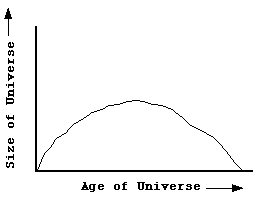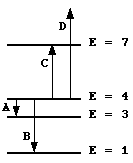
Answer any 12 of the following 14 questions. Each is worth 8 points.
1) The Cepheid Period-Luminosity relation states that the period of a Cepheid variable is directly proportional to its absolute luminosity. Two Cepheid stars are seen in a similar region on the sky, and they are named Gamma and Delta. Delta has a light curve period that is twice as long as Gamma, and both stars have the same apparent luminosity. Assuming there are no effects due to the interstellar medium...
2) The horsehead nebula in Orion is a region of cold gas surrounded by a hotter glowing region of hydrogen gas that is in pressure equilibrium with the cold gas.
3) Suppose we want to emulate the fine work of Paul Marcy and Geoff Butler and search for planets orbiting distant stars using very accurate spectroscopy. Suppose further that every star in our sample has a very large, Jupiter-sized planet orbiting it at a distance similar to the distance between Jupiter and our Sun. Will every star in our sample have a detectable Doppler shift variation because of its orbiting planet? Explain your answer (a diagram may help here).
4) Describe the steps involved in calibrating HubbleŐs law, which demonstrates that the distance to a galaxy is directly proportional to its radial velocity. Be sure to mention why we avoid using local galaxies and cluster galaxies when calibrating HubbleŐs law. You do not need to mention any other possible errors, just the steps in the process.
5) Quasars are incredibly distant and extremely luminous objects (usually 1,000 times more luminous than an entire galaxy) that have a size roughly equal to that of our own solar system. Explain the observational evidence that demonstrates that quasars have a small size (small relative to the size of a galaxy, at least).
6) Below is a graph plotting the size of the Universe vs the age of the Universe.

7) In one region of the sky, we have a close binary system with two stars, Alpha and Beta. Alpha has a surface temperature very similar to that of our Sun, 6,000 K. Beta has a surface temperature close to 10,000 K.
8) The Sun's corona has the strange property that it is hotter the further away from the source of its energy, the Sun.
9) One quantity that is helpful for determining the mass of a large star in a binary system is the orbital distance from this central star to its smaller orbiting companion star. If the system is an eclipsing binary system, we can observe the companion starŐs orbital velocity by watching its Doppler shift during an orbit. Further, we can measure the companion starŐs orbital period by observing the systemŐs light curve. Explain how we can combine this information to find the orbital distance of the small companion star from the central star.
10) Altair has the same set of absorption lines as Rigel, but AltairŐs lines are much narrower. Based on various other observations, we know that the two stars have all of the same properties (mass, temperature, composition, rotation speed) except that they differ in size.
11) Experimental evidence first collected by Einstein tells us that the energy of a photon is directly proportional to its frequency. The atom below contains an electron in the energy level E=4 which can move as shown in A, B, C or D depending on the circumstances.

12) By observing the spectral line characteristics of Deneb, we can estimate its size. Likewise, by observing the color of Deneb, we can estimate its temperature. Knowing these two quantities, we can then determine the absolute luminosity of Deneb using the equation below:

Suppose that between Earth and the star Deneb, there exists an interstellar dust cloud. This cloud causes Deneb to appear redder than it really is (reddening), but it does not affect the apparent luminosity of Deneb in any way (no extinction).
13) The Sun transfers energy from its core to the surface in two ways, via radiation and via convection. Explain which part of the Sun is convective, and explain why in detail it is convective.
14) At the end of its main sequence lifetime, in order to begin fusing Helium, the Sun's core will need to heat up...